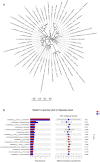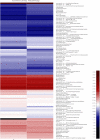Garlic (Allium sativum) based interplanting alters the heavy metals absorption and bacterial diversity in neighboring plants
- PMID: 33712650
- PMCID: PMC7971001
- DOI: 10.1038/s41598-021-85269-4
Garlic (Allium sativum) based interplanting alters the heavy metals absorption and bacterial diversity in neighboring plants
Abstract
Heavy metals are naturally occurring elements that have a high atomic weight and let out in the environment by agriculture, industry, mining and therapeutic expertise and thrilling amassing of these elements pollutes the environment. In this study we have investigated the potential of garlic interplanting in promoting hyper accumulation and absorption of heavy metals to provide a basis for phytoremediation of polluted land. Monoculture and inter-plantation of garlic were conducted to investigate the absorption of cadmium and lead contamination in the land. A group of experiments with single planting (monoculture) of Lolium perenne, Conyza canadensis and Pteris vittata as accumulators were used. The results have shown that garlic has a potential as a hyper accumulate and absorb heavy metals. It was found that the accumulation of Cd and Pb was much higher with inter-planting. Garlic boosts up the absorption of heavy metals in Lolium perenne of Cd 66% and Pb 44% respectively. The Inter-planting of garlic with Pteris vittata promotes the Cd 26% and Pb 15%. While the maximum accumulation of Lead 87% and Cadmium 77% occurred in Conyza canadensis herb plant. The bacterial diversity in the soil was analyzed for each experimental soil and was found that the Proteobacteria, Acidobacteria, Actinobacteria, Firmicutes, and Planctomycetes were commonly abundant in both single planting (monoculture) of ryegrass and interplanting ryegrass with garlic habitats. Variances were observed in the bacterial floral composition of single (monoculture) and intercropping (interplant) soils. Relative abundance of bacterial taxa revealed that the proportion of Proteobacteria, Acidobacteria, and Actinobacteria in the inter-planting group was slightly higher, while Firmicutes and Planctomycetes were low. This study provides the evidence to control the heavy metals contaminated soils with weed species. Growth promotion and heavy metal uptake of neighboring plants proved the specific plant-plant and plant-microbial associations with garlic plants. This inter-planting strategy can be used to improve heavy metal absorption.
Conflict of interest statement
The authors declare no competing interests.
Figures






References
-
- Tchounwou PB, Yedjou CG, Patlolla AK, Sutton DJ. Molecular, Clinical and Environmental Toxicology. Springer; 2012. pp. 133–164.
-
- Dixit R, et al. Bioremediation of heavy metals from soil and aquatic environment: An overview of principles and criteria of fundamental processes. Sustainability. 2015;7:2189–2212. doi: 10.3390/su7022189. - DOI
-
- Alves LR, dos Reis AR, Gratão PL. Heavy metals in agricultural soils: From plants to our daily life. Científica. 2016;44:346–361. doi: 10.15361/1984-5529.2016v44n3p346-361. - DOI
-
- Singh, A. & Singh, R. P. Phytoremdiation species and their modification under by weed varying climatic condition: A changing scenario. Int. J. Sci. Technol. Res.4(11), 3–7 (2015).
Publication types
MeSH terms
Substances
LinkOut - more resources
Full Text Sources
Other Literature Sources

